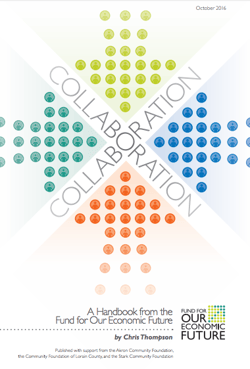Champions of a cause often are eager to convene a collaboration to catalyze change. However, convening stakeholders without first assessing whether the conditions are right and the essential elements are in place is a recipe for coblaboration. The evil twin of collaboration, coblaboration only results in redundant meetings, assignment of blame and little change.
first assessing whether the conditions are right and the essential elements are in place is a recipe for coblaboration. The evil twin of collaboration, coblaboration only results in redundant meetings, assignment of blame and little change.
Collaboration is something that we are often encouraged to do, but rarely told how to do well. As a collaboration of funders that itself supports cross-sector collaborations, The Fund for Our Economic Future believes the “how” of collaboration is vitally important. The Fund is made up of dozens of foundations, educational institutions, health care systems, companies, and governmental units that pool their dollars, leadership and “know how” to advance efforts to increase job creation, job preparation and job access. The Fund designed and continues to support several cross-sector collaborations. Through that work, it has learned the perils of pushing for collaboration before critical preconditions are met, and that effective collaborations require the right kind of process, capacity and leadership.
The Fund recently published Collaboration: A Handbook that shares key lessons learned from nurturing collaborations over the last 13 years. It is a practical guide for funders, nonprofit leaders and other advocates of community change who want to avoid the high cost of failed collaborations – also known as coblaboration. Engaging diverse stakeholders takes time and resources, doing it poorly only generates a lot of talk, too many opinions and not enough change.
Written by Chris Thompson, the Fund’s former director of regional engagement, Collaboration features a detailed description of the “collaboration cycle” and the accompanying collaboration traps that Chris first learned about from Liz Weaver, Director of Tamarack’s Learning Centre.
“I will always remember the first time that Liz shared the collaboration cycle at a workshop she led, as it helped me to better understand why the process of collaboration is so difficult,” Chris said. “My understanding of collaboration continues to deepen thanks to the strong foundation first provided by Liz and Tamarack President Paul Born.”
Collaboration can result in enduring, positive change that we can see, feel and touch. Effective collaboration occurs when independent stakeholders assume shared responsibility for achieving common goals. Effective collaboration is possible when the conditions are right and essential elements are in place. Below are some of the essential conditions for effective collaboration:
Conditions for Collaboration
- Compelling Cause – Stakeholders must be compelled to change their behavioyr and choose to no longer tolerate the status quo.
- Galvanizing Leadership – Disrupting the status quo is risky, challenging work and the collaboration journey is never smooth. Galvanizing leadership unites stakeholders to take on the compelling cause and holds them together when the going gets tough.
- High-Performing Organizations – Collaboration requires organizations to excel within their own operations and cross boundaries. Only those that aspire for high performance are capable of taking on the added challenges posed by cross-sector collaboration.
Ensuring the essential conditions for effective collaboration are in place, change-makers must also ensure that the essential elements of effective collaboration are addressed in the design of an optimal process. These essential elements include:
Essential Elements of Collaboration
- Process – Collaboration demands a rigorous, intentional process that is shaped by the stakeholders and guides how they treat each other, how they make decisions together and what they focus on together.
- Capacity – Key functions need to be performed to facilitate and coordinate the collaboration process, including communications, engagement and shared measurement. Stakeholders need to value, support and sustain the capacity to perform those functions.
- Collaborative Leadership – Collaboration is a challenging journey that works best with experienced guides able to exercise specific leadership skills that help the stakeholders to build trust, gain shared understanding, and assume shared responsibility for achieving common goals.
While champions of a cause often are eager to convene a collaboration to catalyze change, however failing to first assess whether the conditions are right and the essential elements are in place is a recipe that too often results in coblaboration – the evil twin of collaboration – which only results in redundant meetings, assignment of blame and little change.
Learn More:
- Download your copy of Collaboration: A Handbook by Chris Thompson
- Learn more about The Fund for Our Economic Future
- For more on the not-so-fine art of coblaboration, Read Chris’s blog Regional Physics
- Learn more about and contact Chris Thompson via Civic Collaboration Consultants





